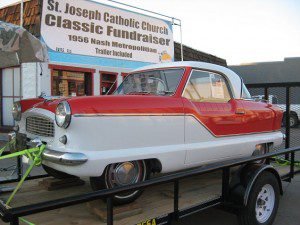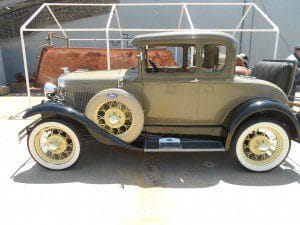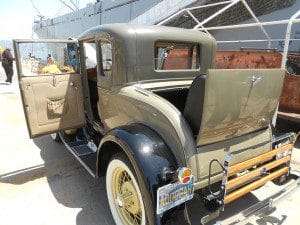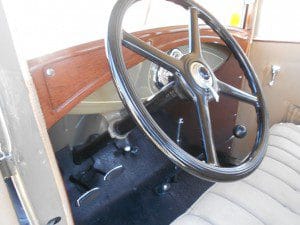With fuel prices at the levels they have been at for a good number of years, and not likely to to go much lower, car manufacturers, the buying public, and the government have all been interested in better car fuel efficiency. Some of the cars today that do well in this respect are among others, the Honda Fit, and the many now Hybrids on the market. All of these automobiles however were still larger than the Nash Metropolitan.
Back over fifty years ago the Nash Automobile Company came out with what I would term a subcompact automobile in the Nash Metropolitan. The Nash Metropolitan was surely offered as a subcompact car alternative in the 1950’s when cars in general were actually getting larger and larger.

The Nash Metrpolitan was thought to be America’s first subcompact. The cars wheelbase was even shorter than the Volkswagon Beetle and the engine was a four cylinder 1.2 liter. The Metropolitan was really designed and targeted as a family’s second car. Nash Metropolitans were built between 1954 and 1962. This was a combined venture between Austin who manufactured the engine, Pinin Farina, which did the design and Nash/Hudson/American Motors, which sold the automobile in the United States under various nameplates.
The beginning of the Nash Motors and the Nash cars is an interesting story. The company was started in 1916 by Charles W. Nash who had been president of General Motors. Nash took over the Thomas B. Jeffrey Company which had been struggling to survive. Nash changed the name to Nash Motors and was able to thrive as a niche automotive producer. Nash was credited with two important things. He was able to keep his company competitive during the Roaring Twenties when the field of auto companies was growing rapidly and he was able to keep the company going through the great depression years of the 1930’s. This was no easy feat since many companies went under in the 1930’s. In 1937, Nash was able to merge with the Kelvinator Corporation. By this time he was 73 years of age and the merger made sense. In fact, Nash became chairman of Nash-Kelvinator Corporation and kept that title until he died in 1948.
The first compact car produced by Nash-Kelvinator was the 1950 Rambler. The Nash Rambler is one of the most popular vintage automobiles today. Prior to this time Nash cars had been much larger.This is a model name still remembered by most auto enthusiasts. The company at this point was run by George W. Mason who had been president under Nash. Mason was a big fan of the compact car concept although many of his engineers were reportedly not. Mason’s idea was to sell the rambler as a luxurious second car for high end buyers. The first model put on the market was a convertible with an electric retracted roof of fabric. While this design had been created, another secret design was being worked on in Utica Michigan.

The results of the focus group were promising. In addition to that, the Rambler, which was small but not as small as the NXI design, was being received pretty well by the public. Costs of producing the new subcompact was a different story. The new NXI prototype was extremely smaller than anything that Nash cars had produced to date and tooling costs became an issue. The answer would be to outsource the construction. George Mason made an arrangement where the bodies of the Metropolitan would be manufactured in England by Fisher & Ludlow, Ltd. The engines would be built by the Austin Motor Company. The result was that the tooling expenses were a fraction of what they would have been in the U.S. This resulted in the Nash Metropolitan being one of the biggest selling imports in North America. You may even remember that Lois Lane drove a Nash Metropolitan on the old 1950’s television series Superman. Obviously, this small unique classic car received a lot of publicity in the 1950’s.
Nash merged with the Hudson Motor Car Company. The new merged company was named the American Motors Corporation. The following years would see quite a lot of changes in nameplates. The Metropolitan model would be built under both the Hudson and Nash name. By the year 1957, AMC would phase out both the Nash and Hudson names although, with the Metropolitan, the name could be seen until 1962. American Motors Corporation would market only the Rambler
For all intents and purposes, the Nash Metropolitan was created due of the wide acceptance of the Rambler back in 1950. Total sales in the U.S. and Canada of the imported Nash Metropolitan were 94,986 between 1953 and 1962.
A great place to view restored Nash Metropolitans include the Metropolitan Pit Stop located at 5330 Laurel Canyon Blvd, North Hollywood California.You may also want to explore the Nash Car Club of America which has information on all Nash automobiles built.


